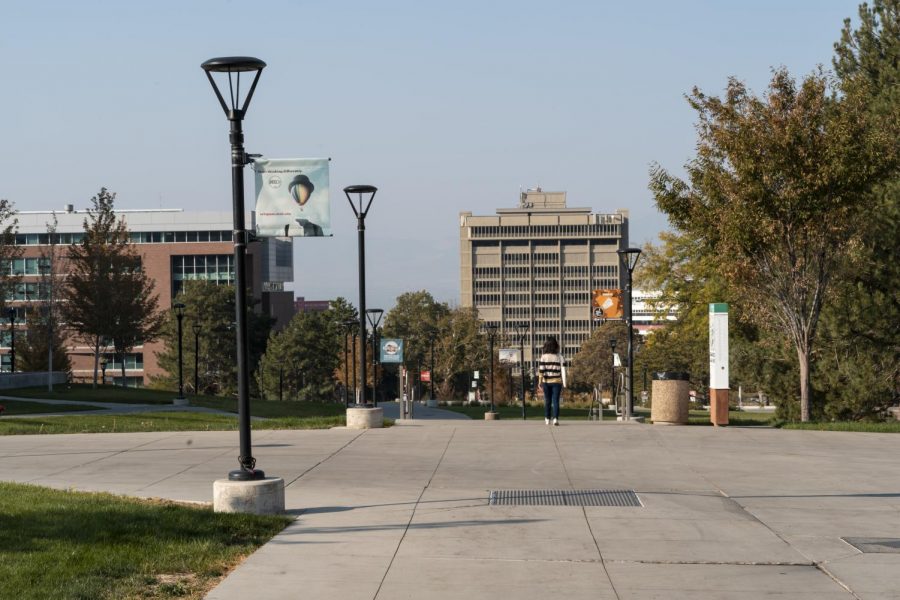Lezaic: Protect College Girls From Grooming
University of Utah Campus in Salt Lake on Oct. 11, 2020. (Photo by Jake Stranzl | The Daily Utah Chronicle)
May 12, 2022
People are starting to have more conversations about the dangers young women face in college, but there is little to show for it. At the University of Utah, we have already lost multiple of our female students, the most recent being Zhifan Dong, to intimate partner violence.
Women aged 18-24 continue to endure three times the risk of sexual violence. To help protect them, we must understand that many abusers utilize grooming as a manipulation tactic to coerce young women. We need to talk about how college-age girls are uniquely vulnerable to grooming so we can establish protections and prevent future harm.
Girls may become “legal” to prey on once they turn 18 — the age at which most students attend college — but they don’t turn into well-adjusted adults overnight. They are hardly given the chance to mature under stable and safe conditions. Financial demands and the inflexible policies of universities, for example, drill into youths’ heads that they need to start acting like full-fledged adults. With such little safety netting, though, this is not viable, realistic or fair. Our increasingly unlivable society leaves many students behind, particularly young women.
By demanding premature maturation and nourishing a fast-paced, hyper-individualistic environment, colleges create the perfect openings for predators. These abusers target people who are “isolated, dependent and more vulnerable to exploitation,” according to the Ann Craft Trust. Many college girls fit the bill. They’re not only fending for themselves for the first time, but they have to balance a grueling education and debt while their confidence falls to an all-time low.
The expectation for girls to compromise their boundaries, which follows them from the moment of their birth, only makes them more susceptible. Our world teaches women to soften their tone and second-guess the validity of their creepy experiences. It silences them, belittles them and paints broken boundaries as a covetable form of romance.
The breaking of boundaries, both mental and physical, constitutes a large part of the grooming process. Predators accomplish this by building their victim’s dependency and cornering them into feeling indebted to them. By selectively fulfilling young girls’ needs, they manipulate them into a false sense of security.
Some of these needs stem from financial insecurity. Universities create much of this instability by financially exploiting their young students. They also create a stressful, high-stakes environment, exacerbated by the additional barriers academia poses for marginalized groups like women.
Other times, parents cause this instability. Some expect their children to move out before they’re ready and fail to prepare them for living independently. Others fully abandon or neglect their children, leaving them without financial or emotional support.
To reduce the risk of groomers preying on their daughters, parents should maintain healthy connections with their daughters. Don’t throw ill-prepared high school graduates into dangerous situations and expect them to cope. Young women need their families to act as a reliable support system.
When young women don’t have this support system, groomers capitalize on the weak spot for their own perverse interests. They weasel their way into lives by gifting money and presents to young women experiencing financial and emotional desperation. They love bomb young women in need of affection and intimacy.
If the predator in question is a professor, he hovers connections, conditional assistance and his positional power over the struggling young woman’s head. Groomers carefully curate this façade and eventually trap women in an abusive situation.
After isolating them from any existing support systems, abusers create a trauma bond to keep their victims tethered to them. Such methods prevent young girls from reaching out for help.
Living in Utah only compounds the danger female students face. The LDS Church often paints Utah as a safe state, but conveniently leaves out the reality of the predatory culture it promotes and thrives on. Just look at Michael James Clay, who used both his religion and his position as a former BYU professor to groom his students.
The abusive and misogynistic nature of our state allows for an environment where the so-called “troubled teen” industry made $328 million in 2015. The industry has recently become exposed as a cesspool of abuse and grooming, functioning perfectly as a means of isolating youth from their families and friends.
The exploitation of vulnerable young people, and especially women, knows no bounds in Utah, where we have consistently ranked last in gender equality. The lasting effects of this abuse on women’s mental health puts them at a disadvantage for the rest of their lives. Meanwhile, nobody advocates for them, least of all the men in power who benefit from corrupt power structures.
Systemic change could improve this reality, and it needs to happen. Education, housing and healthcare should be free and accessible. Nobody should worry about debt, houselessness or hospital bills, especially not women just barely old enough to vote. On top of free tuition, our university must create a better support system for its vulnerable populations, such as its international students.
Parents should concern themselves with their children’s wellbeing more and continue strengthening their relationships with their daughters. Men must hold each other accountable and realize that their silence speaks volumes.
We also need to immediately get rid of the campus police, who have proven themselves an absolutely useless resource both locally and nationally. In many instances, campus police are the very perpetrators who harm the young women on our campus.
Young women should be able to explore their newfound independence without fear of predators targeting them for their innocence and naivety.













John Hedberg • May 18, 2022 at 1:21 pm
“Women aged 18-24 continue to endure three times the risk of sexual violence.”
Is it that women 18-24 endure 3 times the risk of sexual violence, or is it simply that women are 3 times more likely to report it, because of the gender roles society forces down the throats of young men?
I think maybe your misandry is showing…
Your point about grooming is a good one, and it applies not just to sexual exploitation, but also increasingly to propaganda and political exploitation, as well.
We can think better of each other as family, since we are, and watch out for each other with that kindness and consideration, humility and understanding. Suffering is a part of life, and no one escapes it, but we can help each other find meaning in what we share together. With Love.
J Hedberg
Sam S. • May 19, 2022 at 1:37 pm
Let me ask you if YOU, yourself, have been sexually “groomed” and/or sexually abused? If so, then you may speak to this issue. Otherwise, you really have no idea of what Angela speaks. Reading about it is different from experiencing it.
Yes, the “Me Too” movement has been exploited and politicized with a greater agenda than most realize (as has the BlackLM, BlueLM, Climate Change, Green New Deal, Scamdemic, Left/Right, et al. (See Klaus Schwab – “You’ll own nothing and be happy” … NWO singularity/trans-humanism.)
This, “propaganda and political exploitation” to which you refer is actually called #SocialEngineering (also see mind control techniques and MC technology, Blackrock owns US media, etc.).
Nevertheless, the exploitation and abuse of women (and children; lesser degree, men) has been going on for a very long time. It stems from misogyny and the perceived “male privilege” that has been left unchecked for millennia. It runs rampant in “family” and positions of authority.
Your last sentence about “suffering” and helping “each other find meaning” seems a bit bizarre being stated from a man to a woman in this context. With Love.
(Sam’s daughter)
John Hedberg • May 31, 2022 at 10:13 am
Sam,
You’re an idiot and an a**hole. Of course, no one’s suffering in this world matters if it didn’t happen to you, and so you can oblige the rest of us by telling us that our suffering and our feelings matter less or not at all, because that’s how you show how diverse and inclusive you are! Our humanity doesn’t matter, so why shouldn’t you undermine our humanity and dehumanize the rest of us, just because we don’t happen to look just like you?
I’ve been sexually groomed and abused. Did you not read what I wrote? I had my first 2 sexual experiences with babysitters (different genders) when I was about 7, then had a neighbor try to groom my when I was 8. It happens to men & boys, and women are often perpetrators, too, so time to get off your misandrist high horse and admit that we’re all equal and equally worthy of understanding, compassion, love, and the best treatment toward each other, and the only “protected group” is human: this is in fact the basis of our civil and human rights.
The propaganda and political exploitation I refer to is actually the drive by folks like you to divide us and teach us all to hate each other, while telling us you’re dividing us to be inclusive of diversity, and teaching us to hate because hatred is wrong when other people than you do it. The constant drumbeat of “fear, fear, fear” against the “other” has been the basis of political exploitation going back to National Socialist Deutschland and Soviet Europe, the genocide against the Armenians, the genocides in Rwanda and Cambodia, and the genocides both of 20th century China and the CCP against the Uighurs today. Wherever this divisive fear is cultivated, societies collapse, and deaths of our innocent family and neighbors follow by the millions. It didn’t start in the 20th century, but Marxism used and uses this tool extensively, and tens of millions of innocent people died because some people were taught to believe that their hate was righteous, while their neighbor’s was not. As Gandhi pointed out, it’s in the battle against the devils within us that the true war against evil is fought.
The whole “privilege” fantasy is in your mind, a sickness you can use to point at and paint anyone you desire to blame for your own failures and lack of responsibility. That’s very convenient for you, but for those of us who have experienced “privilege” (abuse) from all sides growing up, and from all groups, at a certain point, it becomes obvious we’re all actually individual human beings who don’t adhere to any homogenous group, and so it’s the hate itself that’s spawning the so-called “privilege”, by people who encourage hate, like you! Take some responsibility? Grow the f*** up?
If you’d ever opened a Buddhist text, a history book, or perhaps any book that wasn’t written to blind you by enabling you to express and act on your own worst hatreds of others whom you falsely accuse of hating, you’d already long be acquainted with the concept that human suffering is universal, and it’s in how we face it together, with love, courage, understanding, honesty, compassion, and mutual friendship, which defines our actual virtue, rather than the posturing and pantomiming you’re doing in front of us here now. We’re family. If you miss that, you not only missed out on the entirety of liberal education, but you’re d*** as sh**.
With Love & Forgiveness,
Your Brother, who’s the same inside as you, since we’re all equally human.
J Hedberg